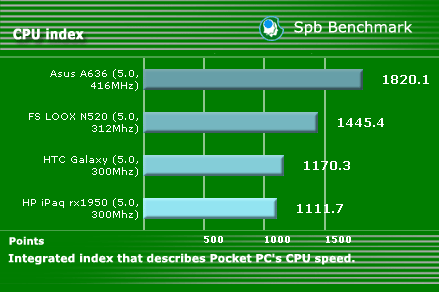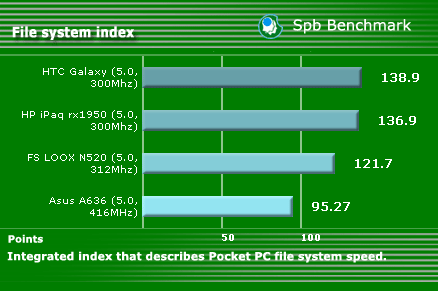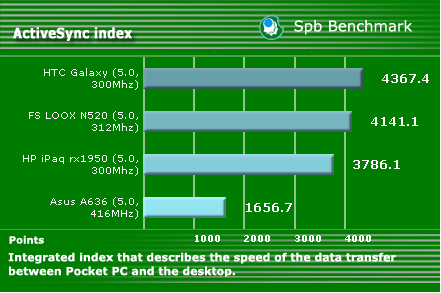HP iPaq rx1950 – PDA with Wi-Fi priced at $200
Standard kit:
- PDA;
- USB-cable for synchronization;
- Charger;
- Firm, cloth case;
- CD with the software;
- Manual
HP keeps its leading positions in Europe (including Russia) among classic PDA makers. Its model line has always been the widest one, no other vendor could or can boast of that great number of different models. However at the moment the line is shrinking, HP switches the focus to communicators. New models appear due to upgrade of old ones. The current PDA line contains 4 models (other handhelds are still available, but out of production), HP iPaq rx1950, three modifications of the hx2000 series. There will be a turning point this year – the number of new communicators will exceed that of new PDAs.

The top model HP iPaq hx4700 is out of production, thus the line is automatically headed by HP iPaq hx2790. Besides the budget model iPaq rz1710 is no longer in the lineup – the handheld was far from ideal and didn’t stand critics in the aspect of price and quality (here you can read the review about it). In all, the iPaq rz1710 turned to be a failure, it didn’t repeat the success of budget hits iPaq 1930/1940.

The company chose the simplest way to create a new budget model and picked up the old, time-proved design. The design was copied from HP iPaq 4150. Once HP iPaq 4150 used to be the flagman of the line, naturally, the company couldn’t keep its filling. What did HP modify to make the handheld less expensive? Firstly, its filling has much in common with the iPaq 1940. Secondly, there is Wi-Fi module and no Bluetooth, which is the key difference from HP iPaq 4150. We can remember another Windows Mobile PDA, which has Wi-Fi and lacks Bluetooth – FS Pocket LOOX N500/N520. Given global expansion of Wi-Fi this segmentation looks justified.


Dimensions remained the same – 113.6x70.6x13.5 mm and weight – 125 g. The front panel is made of metallized plastic and its back part – of black plastic, scratches are hardly seen on it. All details fit each other, nothing is creaking, including the battery cover.

Compared to the iPaq 19xx series almost all elements on the front panel got changed. The power button isn’t combined with the LED, it is separate, but on the previous place. Two LEDs are located by sides of it. The left indicator is in charge of Wi-Fi activity and the right one shows power status and missed reminders. The application buttons have round forms and good position from each other. They feature exact feedback and can be easily pressed. The joystick got more comfortable (compared to the iPaq 19xx), it’s square, which is better than a small circle in the previous models. The speaker is built in the joystick, it is as good and loud as in the iPaq 1940, it doesn’t wheeze even at the highest sound volume level.


At the left side we see a voice recorder button. It isn’t fully dipped and thus is more comfortable than before. You’ll find it comfortable to browse through e-books by pressing it with the middle finger of the right hand. Below is a soft reset button. The infrared port is located now at the bottom end (a controversial solution). Probably there is no place for it on the top. Here at the bottom we see a synchronization port. The right side is traditionally free of control elements – there is only a battery compartment latch.

At the top end nothing seems to be changed: a headphones jack, a mic, an SD/MMC slot (SDIO) and a silo. But there is one nice improvement – the headphones jack now has a 3.5 mm diameter instead of 2.5 mm (so you don’t need an adapter to use your headphones).

The budget handheld comes with the budget kit: a featureless cloth case and a sync cable. The poor set of standard accessories of the rx1950 reminds of the iPaq 1940.

HP iPaq rx1950 comes with a typical Pocket PC screen – a QVGA resolution, 3.5” diagonal, 65K colors. If you remember, the iPaq 1930/1940 series suffered a “yellow screen” problem (white color inverted into yellow, when you look at the screen at an angle). Alas, this problem remained in the new model. However you shouldn’t get upset, this is rather a matter of psychology than a real flaw. Most users will hardly pay attention to this effect.
Battery life
The PDA comes with a removable Li-Ion 1100 mAh battery onboard. Out tests revealed it lasted for 5 hours under the maximum load (video playback, the maximum backlight level). In the reading mode with the minimum backlight the iPaq rx1950 worked for 15 hours 40 minutes. The results are not bad. There is an extended battery for this PDA (1800 mAh), with it the battery life performance will be much higher.


Productivity, specs
As for the memory available the PDA has cut opportunities. Available ROM is 35.07 MB. This isn’t a great problem because of the expansion slot for storage cards. At the same time available RAM is just 23.68 MB and 10 MB of it is occupied at the first launch of the OS. This means that with the plenty of applications installed there will emerge problems for sure with memory shortage in multi-task mode. Some resource-intensive games just can’t be launched.
RAM and ROM are integrated in Samsung SC32442 processor working on 300 MHz (maximum).
We used SPB Benchmark package to test productivity, for this purpose we picked up PDAs similar in functionality and powered by Windows Mobile 5.0.

This index describes Pocket PC’s CPU speed. We have expected results, which distributed according to the nominal clock rate. Pay attention to the fact that similar processors in the iPaq rx1950 and HTC Galaxy perform the same here and forth.

The file system index describes Pocket PC file system speed (read/record/move). This is the weak point of the new operating system on the whole. The iPaq model is slightly losing to HTC Galaxy. Due to this high figure HP iPaq rx1950 together with HTC Galaxy outpace their rivals in the total index.

Synchronization test with desktop PC (file download from PC to PDA and vice versa revealed high results, but not record ones.
We won’t provide the total system index, as it gives little info.
The video playback index is low, only 274 point of 1000 (HTC Galaxy with the same processor performs twice as better).
Video productivity test with TCPMP program completely agrees with the results of HTC Galaxy – 62.3% playing the “heavies” clip (640x480, 24 fps, 1500 Kbit/s, 2-pass XviD). Thus it’s impossible to watch video comfortably without a preliminary conversion.
We have the following resume on this chapter. The PDA has enough productivity to cope with any task, except for non-converted video and heavy games. You face a real problem with tiny RAM size available (you have to think all the time about the number of programs launched and free megabytes).
Interface
The main peculiarity of this handheld is Wi-Fi, at the same time there is no Bluetooth module. You can control Wi-Fi work with iPAQ Wireless utility, which has a special button assigned to it. The work runs smoothly – available wireless networks are found and accessed automatically (you only have to enter the password if necessary). It’s possible to adjust the connection manually.
The interface connector supports COM-port and is compatible with other iPaq series. That is cables of these models and some other peripherals with suit.
Its SD/MMC slot supports SDIO, thus you can insert not only a memory card, but also different peripheral devices, for example, Bluetooth or GPS-receiver. However the peripherals for this slot is quite expensive, they’re not widely available and don’t enjoy popularity.
Software
The handheld is powered by Windows Mobile 5.0 for Pocket PC. You can read about standard programs of this OS in the respective review. We used to the fact that HP PDAs are traditionally supplied with the rich set of useful and necessary programs. Alas, that’s not the case with the iPaq rx1950, there are no extra preinstalled programs in this budget model. May be the software is on the CD? There are no programs for PDA on the disk, except for the utility to listen to audio books. In the kit you can find a voucher, so you can get some software at www.ipaqchoice.com.
Conclusion
HP switches the focus to communicators, step by step the model line of classic PDAs is shrinking. If not consider still available, but out of production iPaq model, the current model line contains just 4 device (we don’t count communicators).
HP iPaq rx1950 is the simplest model, which is opening the line. The company stuck to the way of the least resistance using HP iPaq 4150 as the basis: it replaced the processor, removed Bluetooth module and simplified sales package. This is the right way – in its time the iPaq 4150 was one of the best. There are not many flaws in this PDA, almost all of them result from the low price (the lack of Bluetooth, for example). The old “yellow screen” problem wasn’t solved. There are the following pluses of the model – the new operating system and battery life.
The price depends greatly on the region. The current retail price for Russia is less than $200, the fact suggests no rivals for the iPaq model from new devices. In the US the price tag is $300, for a budget buyer this isn’t interesting, if Dell X51 priced at $240 is available. In the regions with an “adequate” price this handheld will be in demand till the end of its life cycle.
P.S. In the review we forgot to mention that the model is made by the Taiwanese company HTC.
Description:
- Class: business (middle end);
- Position in the line: under HP iPaq hx2190;
- Operating system: Windows Mobile 5.0 for Pocket PC;
- Processor: Samsung SC32442 300 MHz;
- RAM: 32 MB (23.68 MB available to the user);
- ROM: 64 MB (35.07 MB available to the user);
- Connectivity: SD/MMC-slot (SDIO), Wi-Fi (IEEE 802.11b), USB 1.1 client (charging, synchronization), COM (Serial RS232), IrDA (SIR);
- LCD: TFT 3.5” (active zone – 53.5x71 mm), 320x240 pixels, 65K colors;
- Battery: removable Li-Ion 1100 mAh;
- Dimensions: 113.6x70.6x13.5 mm;
- Weight: 125 g.
Anton Kotov (anton.kotov@mobile-review.com)
Translated by Anja Rytchkova (anja.rytchkova@mobile-review.com)
Published — 31 August 2006
Have something to add?! Write us... eldar@mobile-review.com
|














